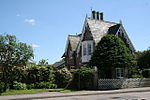Southwell Rural District
Districts of England abolished by the Local Government Act 1972Districts of England created by the Local Government Act 1894English history stubsNewark and SherwoodRural districts of Nottinghamshire ... and 1 more
Use British English from August 2012

Southwell was a rural district in Nottinghamshire, England from 1894 to 1974. It was created by the Local Government Act 1894 as a successor to the Southwell rural sanitary district. It was amended in 1935 under a County Review Order by ceding a few parishes to the Newark Rural District and taking in a few from the disbanded Skegby Rural District. It was abolished in 1974 under the Local Government Act 1972, and was combined with the area of the Newark RD, and Newark borough to form the district of Newark and Sherwood.
Excerpt from the Wikipedia article Southwell Rural District (License: CC BY-SA 3.0, Authors, Images).Southwell Rural District
A617, Newark and Sherwood
Geographical coordinates (GPS) Address Nearby Places Show on map
Geographical coordinates (GPS)
| Latitude | Longitude |
|---|---|
| N 53.1 ° | E -0.95 ° |
Address
A617
NG25 0PH Newark and Sherwood
England, United Kingdom
Open on Google Maps









